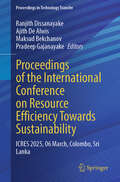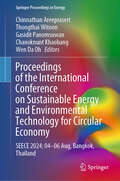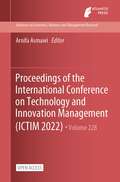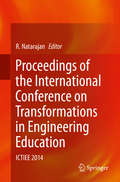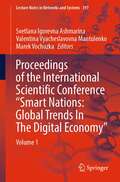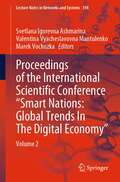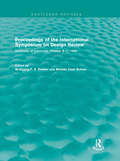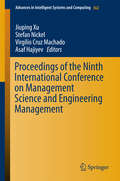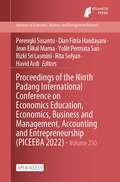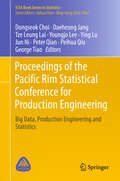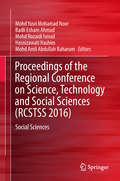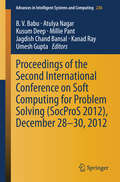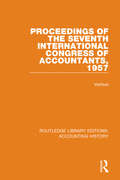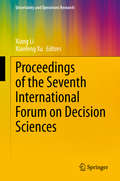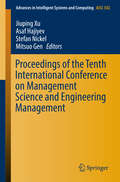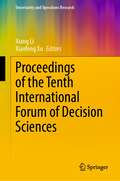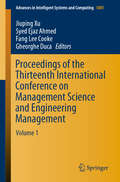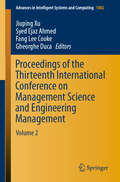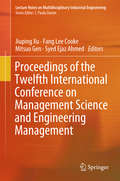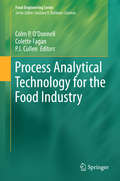- Table View
- List View
Proceedings of the International Conference on Resource Efficiency Towards Sustainability: ICRES 2025, 06 March, Colombo, Sri Lanka (Proceedings in Technology Transfer)
by Ranjith Dissanayake Pradeep Gajanayake Ajith De Alwis Maksud Bekchanov Sujith GunawardhanaThis book showcases the latest knowledge and innovations in resource efficiency and sustainability, addressing critical challenges and opportunities in achieving a sustainable future. It features top-quality and cutting-edge research findings selected from the proceedings of the International Conference on Resource Efficiency Towards Sustainability (ICRES 2025). The themes of this book include Circular Economy, Renewable Energy Solutions, Sustainable Agriculture, Waste Management and Resource Recovery, Climate Change Adaptation and Mitigation, Green Supply Chains, Life Cycle Assessment, and Community Engagement for Sustainability. The ICRES 2025 conference is powered by INSEE Ecocycle, Sri Lanka, whose commitment to advancing sustainable practices has significantly supported the success of this event. For more information, please visit the conference website at https://icres.lk/
Proceedings of the International Conference on Sustainable Energy and Environmental Technology for Circular Economy: SEECE 2024; 04–06 Aug, Bangkok, Thailand (Springer Proceedings in Energy)
by Chinnathan Areeprasert Thongthai Witoon Gasidit Panomsuwan Chanoknunt Khaobang Wen Da OhThis book includes peer reviewed articles from the International Conference on Sustainable Energy and Environmental Technology for Circular Economy (SEECE 2024) held from 04th to 06th August in Bangkok, Thailand. It presents recent advances in sustainable energy and environmental technology for circular economy. Topics include but not limited to are: Renewable energy, biomass conversion, materials for energy and environment, energy efficiency, optimization and AI in energy, energy management, policy and economics, and green manufacturing. It provides a platform for professionals and researchers to exchange ideas on these important topics and foster future collaboration.
Proceedings of the International Conference on Technology and Innovation Management (Advances in Economics, Business and Management Research #665)
by Arnifa AsmawiThis is an open access book.The Centre for Knowledge and Innovation Management (CEKIM), Faculty of Management, Multimedia University is set to hold its second conference titled `International Conference on Technology and Innovation Management 2022 (ICTIM 2022)’ which carries the theme `Humanizing Innovation for Sustainability’. This conference will bring together academic researchers, industry players, policymakers and civil society leaders to engage and share the latest trends and development in technology and innovation management.
Proceedings of the International Conference on Transformations in Engineering Education
by R. NatarajanThis book comprises the proceedings of the International Conference on Transformations in Engineering Education conducted jointly by BVB College of Engineering & Technology, Hubli, India and Indo US Collaboration for Engineering Education (IUCEE). This event is done in collaboration with International Federation of Engineering Education Societies (IFEES), American Society for Engineering Education (ASEE) and Global Engineering Deans' Council (GEDC). The conference is about showcasing the transformational practices in Engineering Education space.
Proceedings of the International Scientific Conference “Smart Nations: Volume 1 (Lecture Notes in Networks and Systems #397)
by Marek Vochozka Svetlana Igorevna Ashmarina Valentina Vyacheslavovna MantulenkoThis book contains contributions from an international scientific conference, “Smart Nations: Global Trends In The Digital Economy”, which was organized by the State University of Management (Moscow). By presenting international research on the issues of the Smart Nations concept, this book includes topics such as state and legal aspects of digital transformation of management systems, new technologies in the digital environment of the information society and smart economy as a new reality. The conference proceedings cover legal, informational, technological and other aspects of socio-economic development in the context of digital innovations. This work addresses theoretical and practical aspects by studying the phenomenon of Smart Nations that requires understanding the modern information technologies, big data analysis, distributed registry management, new microprocessor technologies and broadband data transmission technologies in terms of their usefulness and accessibility to any representative of humanity.
Proceedings of the International Scientific Conference “Smart Nations: Volume 2 (Lecture Notes in Networks and Systems #398)
by Marek Vochozka Svetlana Igorevna Ashmarina Valentina Vyacheslavovna MantulenkoThis book contains contributions from an international scientific conference, “Smart Nations: Global Trends In The Digital Economy”, which was organized by the State University of Management (Moscow). By presenting international research on the issues of the Smart Nations concept, this book includes topics such as smart business in a "smart city", digital marketing systems and Smart Nations phenomenon: social and business aspects. The conference proceedings cover legal, informational, technological and other aspects of socio-economic development in the context of digital innovations. This work provides significant value for scientists, teachers and students of higher educational institutions and specialists, who are researching socio-economic development issues in the era of smart technologies.
Proceedings of the International Symposium on Design Review: University of Cincinnati, October 8-11, 1992 (Routledge Revivals)
by Wolfgang F.E. Preiser Brenda Case ScheerFirst published in 1992, this book collects together the papers presented at the International Symposium on Design Review which was held to address the growing tendency of local governments to institute programs of aesthetic control. The editor argues that the widespread adoption of design review processes in the years preceding the conference necessitated thoroughgoing professional criticism and a number of areas of debate are identified and addressed in the subsequent papers. Are the difficulties experienced by planners, community activists and architects with the process due to its relative youth or inherent flaws in the entire concept? How should mechanical problems like time and expense, the ease with which the process can be manipulated, and general inefficiencies in the system be resolved? More intricate problems are also addressed, such as: who has the power to judge the aesthetic quality of a building, whether design review infringes on the rights of the individual especially under the First Amendment, whether the design review process is "fair", and the difficulty for the reviewer of deciding what is right and what is wrong having taken into account factors that can be highly subjective or contradict more practical concerns.
Proceedings of the Ninth International Conference on Management Science and Engineering Management
by Jiuping Xu Stefan Nickel Virgilio Cruz Machado Asaf HajiyevThis is the Proceedings of the Ninth International Conference on Management Science and Engineering Management (ICMSEM) held from July 21-23, 2015 at Karlsruhe, Germany. The goals of the conference are to foster international research collaborations in Management Science and Engineering Management as well as to provide a forum to present current findings. These proceedings cover various areas in management science and engineering management. It focuses on the identification of management science problems in engineering and innovatively using management theory and methods to solve engineering problems effectively. It also establishes a new management theory and methods based on experience of new management issues in engineering. Readers interested in the fields of management science and engineering management will benefit from the latest cutting-edge innovations and research advances presented in these proceedings and will find new ideas and research directions. A total number of 132 papers from 15 countries are selected for the proceedings by the conference scientific committee through rigorous referee review. The selected papers in the first volume are focused on Intelligent System and Management Science covering areas of Intelligent Systems, Logistics Engineering, Information Technology and Risk Management. The selected papers in the second volume are focused on Computing and Engineering Management covering areas of Computing Methodology, Project Management, Industrial Engineering and Decision Making Systems.
Proceedings of the Ninth Padang International Conference on Economics Education, Economics, Business and Management, Accounting and Entrepreneurship (Advances in Economics, Business and Management Research #672)
by Havid Ardi Perengki Susanto Dian Fitria Handayani Jean Elikal Marna Yollit Permata Sari Rizki Sri Lasmini Rita SofyanThis is an open access book.This conference is aimed to provide a medium for participants in disseminating their research ideas and results as well as developing their networks. Through the participants’ contribution, it is hoped that this conference could provide a deeper understanding of Economics Education, Economics, Business and Management, Accounting and Entrepreneurship issues.The theme for The Ninth Padang International Conference on Economics Education, Economics, Business and Management, Accounting and Entrepreneurship (PICEEBA) is “Leap to the imminent future: Seizing Opportunities in Education, Economics, and Business”. In this conference, we invite experts, practitioners and observers from all around the globe the to sit together to explore various issues and debates on economics education, economics, bussines and management, accounting, and entrepreneurship.The conference will be held online on May 21st, 2022 via Zoom Meeting and "UNP Video Streaming" Youtube Channel. We welcome empirical or conceptual contributions by any method or approach, especially those relevant to the issues of Education in Economics, Economics, Business and Management, Accounting and Entrepreneurship
Proceedings of the Pacific Rim Statistical Conference for Production Engineering: Big Data, Production Engineering And Statistics (ICSA Book Series in Statistics)
by Tze Leung Lai Jun Ni Ying Lu Youngjo Lee Dongseok Choi Daeheung Jang Peter Qian Peihua Qiu George TiaoThis book presents the proceedings of the 2nd Pacific Rim Statistical Conference for Production Engineering: Production Engineering, Big Data and Statistics, which took place at Seoul National University in Seoul, Korea in December, 2016. The papers included discuss a wide range of statistical challenges, methods and applications for big data in production engineering, and introduce recent advances in relevant statistical methods.
Proceedings of the Regional Conference on Science, Technology and Social Sciences: Social Sciences (RCSTSS #2016)
by Badli Esham Ahmad Mohd Yusri Mohamad Noor Mohd Rozaidi Ismail Hasnizawati Hashim Mohd Amli Abdullah BaharumThis book features papers addressing a broad range of topics including psychology, religious studies, natural heritage, accounting, business, communication, education and sustainable development. It serves as a platform for disseminating research findings by academicians of local, regional and global prominence, and acts as a catalyst to inspire positive innovations in the development of the region. It is also a significant point of reference for academicians and students. This collection of selected social sciences papers is based on the theme “Soaring Towards Research Excellence”, presented at the Regional Conference of Sciences, Technology and Social Sciences (RCSTSS 2016), organised bi-annually by Universiti Teknologi MARA Cawangan Pahang, Malaysia.
Proceedings of the Second International Conference on Soft Computing for Problem Solving (SocProS 2012), December 28-30, 2012
by Millie Pant Kusum Deep Jagdish Chand Bansal Atulya Nagar B. V. Babu Kanad Ray Umesh GuptaThe present book is based on the research papers presented in the International Conference on Soft Computing for Problem Solving (SocProS 2012), held at JK Lakshmipat University, Jaipur, India. This book provides the latest developments in the area of soft computing and covers a variety of topics, including mathematical modeling, image processing, optimization, swarm intelligence, evolutionary algorithms, fuzzy logic, neural networks, forecasting, data mining, etc. The objective of the book is to familiarize the reader with the latest scientific developments that are taking place in various fields and the latest sophisticated problem solving tools that are being developed to deal with the complex and intricate problems that are otherwise difficult to solve by the usual and traditional methods. The book is directed to the researchers and scientists engaged in various fields of Science and Technology.
Proceedings of the Second International Conference on the Future of ASEAN (ICoFA) 2017 – Volume 2: Science And Technology
by Rizauddin Saian Mohd Azwan AbbasThis book examines how business, the social sciences, science and technology will impact the future of ASEAN. Following the ASEAN VISION 2020, it analyses the issues faced by ASEAN countries, which are diverse, while also positioning ASEAN as a competitive entity through partnerships. On the 30th anniversary of ASEAN, all ASEAN leaders agreed to the establishment of the ASEAN VISION 2020, which delineates the formation of a peaceful, stable and dynamically developed region while maintaining a community of caring societies in Malaysia, Indonesia, Singapore, Brunei, Vietnam, Thailand, the Philippines, Myanmar, Laos and Cambodia. In keeping with this aspiration, Universiti Teknologi MARA Perlis took the initial steps to organise conferences and activities that highlight the role of the ASEAN region. The Second International Conference on the Future of ASEAN (ICoFA) 2017 was organised by the Office of Academic Affairs, Universiti Teknologi MARA Perlis, to promote more comprehensive integration among ASEAN members. This book, divided into two volumes, offers a useful guide for all those engaged in research on business, the social sciences, science and technology. It will also benefit researchers worldwide who want to gain more knowledge about ASEAN countries
Proceedings of the Seventh International Congress of Accountants, 1957 (Routledge Library Editions: Accounting History #35)
by VariousThis book, first published in 1988, contains the complete account of the Seventh International Congress of Accountants in 1957. Featuring analysis of the modernisation of accounting, public accountants and internal auditing, among others, this is a valuable research book on the development of the profession.
Proceedings of the Seventh International Forum on Decision Sciences (Uncertainty and Operations Research)
by Xiang Li Xiaofeng XuThese proceedings focus on selected aspects of the current and upcoming trends in transportation, logistics, supply chain management, and decision sciences. In detail the included scientific papers analyze the problem of Decision Making under Uncertainty, Stochastic Optimization, Transportation, Logistics and Intelligent Business. The variety of the papers delivers added value for both scholars and practitioners. This book is the documentation of the symposium “The Seventh International Forum on Decision Sciences”, which took place in Windsor, Canada.
Proceedings of the Sixth International Forum on Decision Sciences (Uncertainty and Operations Research)
by Xiang Li Xiaofeng XuThe proceedings focus on selected aspects of the current and upcoming trends in transportation, logistics and decision-making. In detail the included scientific papers analyze the problem of Decision Making under Uncertainty, Stochastic Optimization, Transportation, Logistics and Intelligent Business. The variety of the papers delivers added value for both scholars and practitioners. This book is the documentation of the symposium “The Sixth International Forum on Decision Sciences”, which took place in Jinan, Shandong province, China.
Proceedings of the Tenth International Conference on Management Science and Engineering Management
by Jiuping Xu Stefan Nickel Asaf Hajiyev Mitsuo GenThis book presents the proceedings of the Tenth International Conference on Management Science and Engineering Management (ICMSEM2016) held from August 30 to September 02, 2016 at Baku, Azerbaijan and organized by the International Society of Management Science and Engineering Management, Sichuan University (Chengdu, China) and Ministry of Education of Azerbaijan. The aim of conference was to foster international research collaborations in management science and engineering management as well as to provide a forum to present current research findings. The presented papers were selected and reviewed by the Program Committee, made up of respected experts in the area of management science and engineering management from around the globe. The contributions focus on identifying management science problems in engineering, innovatively using management theory and methods to solve engineering problems effectively and establishing novel management theories and methods to address new engineering management issues.
Proceedings of the Tenth International Forum of Decision Sciences (Uncertainty and Operations Research)
by Xiang Li Xiaofeng XuThis book focuses on selected aspects of the current and upcoming trends in transportation, logistics and decision making. In detail the included transportation management, optimization and management of logistics system, big data technology and method, financial engineering and risk management, investment decision and risk management, data-driven process management decision, scheduling optimization and combination decision, theory and method of forecasting and decision making, data mining and knowledge management, operation and green supply chain management, industrial engineering and operation management, information system and business intelligence, Internet + green manufacturing, strategic emerging industries and Industrial finance, big data and smart city. The variety of the papers delivers added value for both scholars and practitioners. This book is the documentation of International Conference on Intelligent Transportation and Logistics with Big Data & International Forum on Decision Sciences, which took place in Harbin, Heilongjiang province, China, in 2022.
Proceedings of the Thirteenth International Conference on Management Science and Engineering Management: Volume 1 (Advances in Intelligent Systems and Computing #1001)
by Jiuping Xu Gheorghe Duca Fang Lee Cooke Syed Ejaz AhmedThis book gathers the proceedings of the 13th International Conference on Management Science and Engineering Management (ICMSEM 2019), which was held at Brock University, Ontario, Canada on August 5–8, 2019. Exploring the latest ideas and pioneering research achievements in management science and engineering management, the respective contributions highlight both theoretical and practical studies on management science and computing methodologies, and present advanced management concepts and computing technologies for decision-making problems involving large, uncertain and unstructured data. Accordingly, the proceedings offer researchers and practitioners in related fields an essential update, as well as a source of new research directions.
Proceedings of the Thirteenth International Conference on Management Science and Engineering Management: Volume 2 (Advances in Intelligent Systems and Computing #1002)
by Jiuping Xu Gheorghe Duca Fang Lee Cooke Syed Ejaz AhmedThis book gathers the proceedings of the 13th International Conference on Management Science and Engineering Management (ICMSEM 2019), which was held at Brock University, Ontario, Canada on August 5–8, 2019. Exploring the latest ideas and pioneering research achievements in management science and engineering management, the respective contributions highlight both theoretical and practical studies on management science and computing methodologies, and present advanced management concepts and computing technologies for decision-making problems involving large, uncertain and unstructured data. Accordingly, the proceedings offer researchers and practitioners in related fields an essential update, as well as a source of new research directions.
Proceedings of the Twelfth International Conference on Management Science and Engineering Management (Lecture Notes on Multidisciplinary Industrial Engineering)
by Jiuping Xu Mitsuo Gen Fang Lee Cooke Syed Ejaz AhmedThis proceedings book is divided in 2 Volumes and 8 Parts. Part I is dedicated to Decision Support System, which is about the information system that supports business or organizational decision-making activities; Part II is on Computing Methodology, which is always used to provide the most effective algorithm for numerical solutions of various modeling problems; Part III presents Information Technology, which is the application of computers to store, study, retrieve, transmit and manipulate data, or information in the context of a business or other enterprise; Part IV is dedicated to Data Analysis, which is a process of inspecting, cleansing, transforming, and modeling data with the goal of discovering useful information, suggesting conclusions, and supporting decision-making; Part V presents papers on Operational Management, which is about the plan, organization, implementation and control of the operation process; Part VI is on Project Management, which is about the initiating, planning, executing, controlling, and closing the work of a team to achieve specific goals and meet specific success criteria at the specified time in the field of engineering; Part VII presents Green Supply Chain, which is about the management of the flow of goods and services based on the concept of “low-carbon”; Part VIII is focused on Industry Strategy Management, which refers to the decision-making and management art of an industry or organization in a long-term and long-term development direction, objectives, tasks and policies, as well as resource allocation.
Process Analytical Technology for the Food Industry
by P. J. Cullen Colm P. O'Donnell Colette FaganThe Process Analytical Technology (PAT) initiative aims to move from a paradigm of 'testing quality in' to 'building quality in by design'. It can be defined as the optimal application of process analytical technologies, feedback process control strategies, information management tools, and/or product-process optimization strategies. Recently, there have been significant advances in process sensors and in model-based monitoring and control methodologies, leading to enormous opportunities for improved performance of food manufacturing processes and for the quality of food products with the adoption of PAT. Improvements in process efficiency, reduced product variability, enhanced traceability, process understanding, and decreased risk of contamination are some of the benefits arising from the introduction of a PAT strategy in the food industry. Process Analytical Technology for the Food Industry reviews established and emerging PAT tools with potential application within the food processing industry. The book will also serve as a reference for industry, researchers, educators, and students by providing a comprehensive insight into the objectives, challenges, and benefits of adopting a Process Analytical Technology strategy in the food industry.
Process Analytics Simulation: Solutions
by Robert S. Huckman Willy Shih Roy D. Shapiro Michael W. Toffel Aizan RadziA set of exercises and instructions to be used with the Process Simulator software made by Pro Model. These exercises allow students to investigate the impact of variable processing times on the performance of simple in-line processes. Includes color exhibits.
Process Analytics Simulation: Solutions
by Robert S. Huckman Roy D. ShapiroA set of exercises and instructions to be used with the Process Simulator software made by Pro Model. These exercises allow students to investigate the impact of variable processing times on the performance of simple in-line processes. Includes color exhibits.
Process Capability Analysis: Estimating Quality
by Neil W. PolhemusProcess Capability Analysis: Estimating Quality presents a systematic exploration of process capability analysis and how it may be used to estimate quality. The book is designed for practitioners who are tasked with insuring a high level of quality for the products and services offered by their organizations. Along with describing the necessary statistical theory, the book illustrates the practical application of the techniques to data that do not always satisfy the standard assumptions. <P><P> The first two chapters deal with attribute data, where the estimation of quality is restricted to counts of nonconformities. Both classical and Bayesian methods are discussed. The rest of the book deals with variable data, including extensive discussions of both capability indices and statistical tolerance limits. Considerable emphasis is placed on methods for handling non-normal data. Also included are discussions of topics often omitted in discussions of process capability, including multivariate capability indices, multivariate tolerance limits, and capability control charts. A separate chapter deals with the problem of determining adequate sample sizes for estimating process capability. <P><P> Features: <li> Comprehensive treatment of the subject with consistent theme of estimating percent of nonconforming product or service. <li> Includes Bayesian methods. <li> Extension of univariate techniques to multivariate data. <li> Demonstration of all techniques using Statgraphics data analysis software. <P><P> Neil Polhemus is Chief Technology Officer at Statgraphics Technology and the original developer of the Statgraphics program for statistical analysis and data visualization. Dr. Polhemus spent 6 years on the faculty of the School of Engineering and Applied Science at Princeton University before moving full-time to software development and consulting. He has taught courses dealing with statistical process control, design of experiments and data analysis for more than 100 companies and government agencies.
